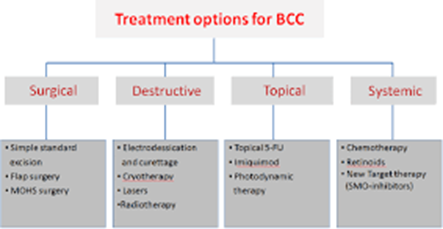A nurse is caring for a client who has questions concerning the various treatment options for his new diagnosis of basal cell carcinoma. Which of the following treatments should the nurse include in the discussion? (Select all that apply)
Radiation therapy
Topical corticosteroids
Micrographic surgery
Electrosurgery
Correct Answer : A,C,D
Choice A rationale: radiation therapy is one of the possible management options for basal cell carcinoma (BCC) that uses high-energy rays to kill the cancerous cells.
Choice B rationale: this is incorrect since topical corticosteroids are ineffective in BCC management and may worsen the patient’s condition by suppressing their immune system.
Choice C rationale: micrographic surgery can be used in BCC management and it involves the removal of thin layers of skin to a point where no cancer cells can be detected.
Choice D rationale: this is appropriate and involves the use of electric current to burn off the cancer cells.

Nursing Test Bank
Naxlex Comprehensive Predictor Exams
Related Questions
Correct Answer is C
Explanation
Choice A rationale: The nurse should not include any opinions, judgments, or blame in the incident report, as this could be used as evidence in a legal case. Therefore, the nurse should not question the charge nurse about care deficits.
Choice B rationale: The nurse should not include any opinions, judgments, or blame in the incident report, as this could be used as evidence in a legal case. Therefore, the nurse should not document what the nurse believes was the cause of ulcer development.
Choice C rationale: This is important because it provides factual information about the client's condition and perception of the event, which could help in identifying the factors that contributed to the ulcer development and preventing further complications.
Choice D rationale: Documenting in the client's medical record that the nurse completed an incident report is not the primary purpose of the incident report itself. Incident reports are internal documents used by the healthcare facility to track and investigate events. The documentation in the client's medical record should focus on the client's clinical condition, care provided, and response to treatment.
Correct Answer is C
Explanation
- A: Swabbing the wound bed is an essential step in obtaining a wound culture, but it is not the first action that should be taken. This step is performed after the wound has been cleansed to ensure that the sample is not contaminated with debris or bacteria from the surrounding skin.
- B: Cleansing the area around the wound with sterile saline is the correct first step. This action helps to remove any contaminants or debris from the wound surface, ensuring that the culture obtained is from the wound itself and not from the surrounding skin, which could lead to inaccurate results.
- C: Donning sterile gloves is a crucial step to maintain sterility during the procedure. However, it is not the first action because the nurse must first cleanse the wound area to prevent contamination of the culture specimen.
- D: Placing the collection tube in a specimen bag is done after obtaining the wound culture to transport the specimen to the laboratory. This is one of the final steps in the process, not the first.
Whether you are a student looking to ace your exams or a practicing nurse seeking to enhance your expertise , our nursing education contents will empower you with the confidence and competence to make a difference in the lives of patients and become a respected leader in the healthcare field.
Visit Naxlex, invest in your future and unlock endless possibilities with our unparalleled nursing education contents today
Report Wrong Answer on the Current Question
Do you disagree with the answer? If yes, what is your expected answer? Explain.
Kindly be descriptive with the issue you are facing.
